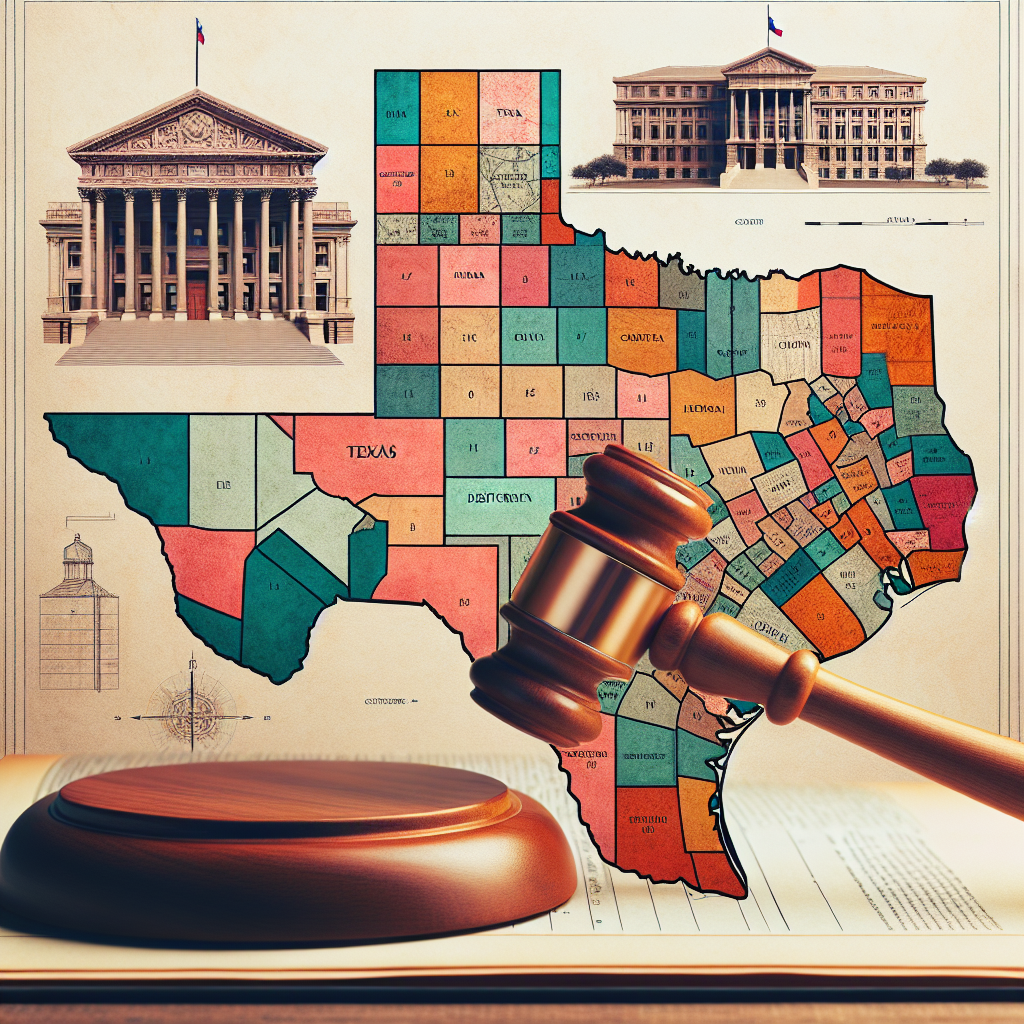On a recent Friday, Texas made a significant move by appealing to the Supreme Court, seeking permission to implement a congressional redistricting map that had been previously deemed racially discriminatory by a lower court. The urgency of this request arises from a decision made by a three-judge district court in Texas, which ruled against the map’s use for the upcoming 2026 elections. This ruling was based on the conclusion that the map unconstitutionally sorts voters based on race, raising concerns about its implications for electoral fairness.
Legal Background and Current Status
Texas Solicitor General William Peterson presented the state’s case, emphasizing the potential risks posed by the district court’s injunction. He argued that the ruling could disrupt the electoral process by preventing candidates from appearing on the ballot, thereby threatening the integrity of the elections. Peterson urged the Supreme Court to pause the lower court’s ruling by December 1, allowing time for the justices to deliberate on the matter. In a swift response, Justice Samuel Alito issued an administrative stay, temporarily halting the district court’s order and requiring the challengers to submit their response promptly.
Political Implications and Historical Context
The controversy surrounding the redistricting map is rooted in a call from former President Donald Trump earlier this year, who urged Texas lawmakers to create additional congressional districts that would favor Republican candidates. Currently, the Republican Party holds a slim majority in the House of Representatives, with 219 seats compared to the Democrats’ 214, alongside two vacant seats. Historical patterns indicate that the president’s party typically loses seats in the House during midterm elections, making the stakes particularly high for Republicans in the upcoming elections. According to a report by the supreme court voting case, the implications of this redistricting effort extend beyond Texas, potentially influencing national political dynamics.
Concerns from Lawmakers
Despite the push from the former president, many Texas lawmakers expressed caution regarding the request to redraw congressional districts. Their concerns centered on the potential risks of altering existing Republican strongholds, which could jeopardize the incumbency of several Republican representatives. The balance of power in the House is a critical issue, especially in light of historical trends indicating that the party in the White House often faces challenges during midterm elections. As the situation evolves, the implications of the Supreme Court’s decision could have far-reaching effects on Texas politics and the broader national landscape, particularly as the supreme court decision looms on the horizon.
Texas’s legal battle over its congressional redistricting map has escalated as the state appeals to the Supreme Court for permission to use a map that a lower court has deemed racially discriminatory. This request comes in the wake of a recent ruling by a three-judge district court, which concluded that the map violates constitutional principles by sorting voters based on race. The implications of this decision are profound, as the map was designed to bolster Republican representation in the upcoming elections, particularly in light of the narrow majority the party currently holds in the House of Representatives.
Legal Background and Current Proceedings
The controversy surrounding the congressional map traces back to directives from former President Donald Trump, who urged Texas lawmakers to redraw electoral boundaries to create additional districts favorable to Republicans. Following a 2-1 decision by the district court that blocked the use of this map for the 2026 elections, Texas Solicitor General William Peterson has argued that the ruling could disrupt the electoral process. He emphasized that the major election law case could lead to significant confusion regarding candidate placement on ballots, potentially jeopardizing the integrity of the upcoming elections.

Supreme Court’s Response
In response to Texas’s appeal, Justice Samuel Alito granted an administrative stay, allowing the state to temporarily use the contested map while the Supreme Court deliberates on the matter. This decision is critical, as it provides Texas with a window to prepare for the elections without the uncertainty posed by the district court’s ruling. However, the challengers to the map have been instructed to submit their responses to the Supreme Court by a specified deadline, ensuring that the legal discourse surrounding the issue continues to unfold rapidly.
Implications for Voter Representation
The implications of this legal battle extend beyond the immediate electoral landscape. The district court’s ruling highlights ongoing concerns regarding racial discrimination in redistricting processes. Critics argue that the map not only undermines the principle of fair representation but also exacerbates existing disparities in political power among different racial groups. As the Supreme Court prepares to hear arguments, the outcome could set a significant precedent regarding how states approach redistricting and the safeguards necessary to protect minority voting rights.
Political Landscape and Future Considerations
The political landscape in Texas is particularly sensitive, given the current balance of power in the House of Representatives. With Republicans holding a slim majority, any changes to district boundaries could have a profound impact on future elections. As noted by experts, the history of midterm elections shows that the party of the sitting president often loses seats, making the stakes even higher for Republican lawmakers in Texas. The scotus updates will be closely monitored as they may influence the strategies employed by both parties in the lead-up to the elections.
In conclusion, the Supreme Court’s decision on Texas’s appeal could reshape the electoral map significantly, affecting not only the immediate political landscape but also the broader discourse around race and representation in American democracy. As this case unfolds, it will be crucial for observers to consider its long-term implications for voter rights and the integrity of the electoral process.

As the legal battle over Texas’s congressional redistricting map intensifies, the implications of the Supreme Court’s decision could resonate far beyond state borders. The request from Texas to utilize a map previously deemed racially discriminatory raises significant questions about electoral integrity and the representation of minority voters. The urgency of the matter is underscored by the approaching deadlines for the 2026 elections, as the state seeks clarity from the highest court in the land.
Legal Context and Implications of the Redistricting Map
The controversy surrounding the redistricting map stems from a ruling by a three-judge district court, which found that the map unconstitutionally sorts voters based on race. This ruling has raised alarms among Texas officials, who argue that the decision could disrupt the electoral process. Texas Solicitor General William Peterson emphasized that the district court’s last-minute injunction creates confusion that could jeopardize candidates’ placements on the ballot and undermine the election’s integrity.
The Supreme Court’s involvement is critical, especially given the political landscape in which Republicans are aiming to solidify their control of the House of Representatives. The request for an administrative stay will allow the justices time to consider the implications of the lower court’s ruling while ensuring that the electoral process remains on track. The stakes are high, with the potential to influence not only Texas politics but also the broader national political dynamics.
Political Motivations Behind Redistricting Efforts
Political motivations play a crucial role in the redistricting process, particularly in a state like Texas, which has experienced significant demographic shifts in recent years. Following President Donald Trump’s call for Texas to redraw its congressional map, the urgency to create additional districts favorable to Republicans has intensified. Lawmakers in Texas are grappling with the delicate balance of maintaining their party’s dominance while ensuring fair representation for all constituents.

Critics of the proposed map highlight the potential for gerrymandering, where district lines are manipulated to favor one party over another. This accusation is particularly poignant in light of the recent court ruling, which underscores the need for a transparent and equitable redistricting process. The tension between political ambition and the necessity for fair representation poses a significant challenge for Texas lawmakers as they navigate these complex issues.
Future Considerations and the Role of the Supreme Court
The Supreme Court’s decision on whether to allow Texas to proceed with its contested redistricting map will set a precedent for similar cases across the nation. As states grapple with their own redistricting efforts, the implications of this ruling could influence how electoral maps are drawn in the future. Observers are closely monitoring the situation, as it could signal a shift in how courts interpret laws relating to race and electoral representation.
In addition to the immediate impact on Texas elections, this case underscores the broader national conversation about voting rights and representation. The complexities of race, politics, and electoral integrity are at the forefront of this legal battle, making it a pivotal moment in the ongoing struggle for equitable representation in American democracy. As the Supreme Court prepares to review the case, the outcome will likely resonate throughout the political landscape, influencing both state and national elections for years to come.
For those interested in the upcoming legal discussions, the Supreme Court is set to address key issues in january, which may further illuminate the court’s stance on redistricting and voter representation.